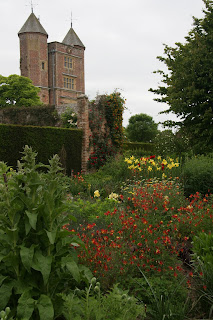This year was my third visit to the amazing Chelsea Flower Show in London, England. Always an exciting adventure, it was just as (fill in your favourite superlative here) as ever. The interior of the Grand Pavilion appeared crammed with plants from every nursery business in Britain, including a yellow Streptocarpus, produced by Lynne Dibley, owner of Dibleys Nurseries.
Streptocarpus colours follow a range through pink, blue or purple, but this one is truly unique. It took eleven years and endless hybridizations to produce a yellow variety. Naturally, I had to have one, then and there. I asked Lynne (I think it was Lynne) if they were for sale — NO. Can I buy one anywhere — NO. Will they be available soon in Canada— NO. Will you ship to Canada — NO. I left my disappointment in the Grand Pavilion and went on to view the large show gardens.
As ever, the competition is intense to win a gold medal at Chelsea. The large gardens are sponsored, and it’s no wonder considering they cost hundreds of thousands to create, and stay in perfect condition, for only five days. And I thought I went over board at the garden centre today with three trays of plants. A number of gold medals were awarded, but only one garden in each class receives Best in Show. This year it went to The Laurent-Perrier Garden Designed by Tom Stuart-Smith, a winner of six gold medals at Chelsea.
Try to hire him for a front-yard makeover now — good luck. His winning design was a dreamy understatement of simple elements — large, zinc water tanks, full to the brim and surrounded by only green and white plants. Around me, I could feel a softening in the energy in the crowd around me as we gazed at an example of perfection in design. Not withstanding my level of awe, I confess, I wanted to run and soak my weary feet in one of the tanks.
The judging of gardens at Chelsea is done by professionals, but there is one award much sought after — The BBC RHS Peoples' Award, chosen by TV viewers and show visitors. It was awarded this year to Cleve West for The Bupa garden. How do I describe a garden of pathways and colourful plants dominated by a big stone globe? Same as those who voted for it — Wow! Designed partially as a sensory garden, it was one of the few show gardens that would be moved to a permanent location, a nursing centre in Battersea, south-west London.
I did have another favourite, and if you remember the sixties fondly, this one may have been yours. Many will be surprised to learn, that the late Beatle, George Harrison, was a passionate gardener. In fact, he dedicated his 1980 memoir, I Me Mine, to gardeners everywhere. This year at Chelsea, he was commemorated in return with a garden designed by his widow, Olivia Harrison, and landscape designer, Yvonne Innes.
The garden was planned to show the stages of George’s life, beginning with a rough patch of grass reminiscent of his father’s garden plot in Arnold Grove, George’s birthplace. A mosaic path of explosively psychedelic colours wound through the garden, past a glass wall bearing an image of a contemplative George.
His lyrics, “Floating down the stream of time, from life to life with me” were displayed beside a tranquil pool below. The garden ends at a peacefully serene, white pavilion. Imagine.
By late afternoon, I decided to explore the streets of Chelsea. I was surprised to discover Tite Street, once the home of playwright, Oscar Wilde. I don’t believe Oscar was much of a gardener, but I’m fond of a quote of his that reflects in a way what Chelsea is all about: “It seems to me that we all look at Nature too much, and live with her too little.”
By late afternoon, I decided to explore the streets of Chelsea. I was surprised to discover Tite Street, once the home of playwright, Oscar Wilde. I don’t believe Oscar was much of a gardener, but I’m fond of a quote of his that reflects in a way what Chelsea is all about: “It seems to me that we all look at Nature too much, and live with her too little.”





